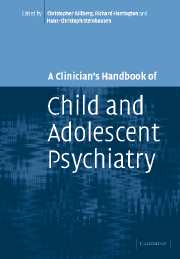Book contents
- Frontmatter
- Contents
- Preface
- List of contributors
- 1 Brain disorders
- 2 Substance use disorders
- 3 Schizophrenia and schizophrenia-like disorders
- 4 Affective disorders
- 5 Anxiety disorders
- 6 Obsessive-compulsive disorders
- 7 Adjustment disorders
- 8 Post-traumatic stress disorder
- 9 Functional somatic symptoms and somatoform disorders in children
- 10 Eating disorders: anorexia nervosa and bulimia nervosa
- 11 Sleep disorders
- 12 Personality disorders
- 13 Mental retardation/learning disability
- 14 Specific developmental disorders of speech and language
- 15 Reading and other learning disorders
- 16 Autism spectrum disorders
- 17 Hyperkinetic disorders
- 18 Conduct disorders
- 19 Elective mutism
- 20 Attachment and disorders of attachment
- 21 Tic disorders
- 22 Elimination disorders: enuresis and encopresis
- 23 Physical and sexual abuse
- 24 Gender identity disorders
- Index
- References
5 - Anxiety disorders
Published online by Cambridge University Press: 06 August 2009
- Frontmatter
- Contents
- Preface
- List of contributors
- 1 Brain disorders
- 2 Substance use disorders
- 3 Schizophrenia and schizophrenia-like disorders
- 4 Affective disorders
- 5 Anxiety disorders
- 6 Obsessive-compulsive disorders
- 7 Adjustment disorders
- 8 Post-traumatic stress disorder
- 9 Functional somatic symptoms and somatoform disorders in children
- 10 Eating disorders: anorexia nervosa and bulimia nervosa
- 11 Sleep disorders
- 12 Personality disorders
- 13 Mental retardation/learning disability
- 14 Specific developmental disorders of speech and language
- 15 Reading and other learning disorders
- 16 Autism spectrum disorders
- 17 Hyperkinetic disorders
- 18 Conduct disorders
- 19 Elective mutism
- 20 Attachment and disorders of attachment
- 21 Tic disorders
- 22 Elimination disorders: enuresis and encopresis
- 23 Physical and sexual abuse
- 24 Gender identity disorders
- Index
- References
Summary
Introduction
The anxiety disorders constitute a broad spectrum of syndromes ranging from very circumscribed anxiety to pervasive, sometimes ‘free-floating’ anxiety or worry. As such, they are the most common group of psychiatric illnesses in children and adolescents (as well as adults). With the most recent editions of the Diagnostic and Statistical Manual of Mental Disorders (DSM-IV; APA, 1994) and, similarly, the International Statistical Classification of Diseases and Related Health Problems (ICD-10; WHO, 1992), the symptoms of children, adolescents and adults can be categorized by eight major but separate diagnostic syndromes associated with anxiety: panic disorder with agoraphobia, panic disorder without agoraphobia, agoraphobia without history of panic, specific phobia, social phobia, obsessive-compulsive disorder, post-traumatic stress disorder and generalized anxiety disorder.
Additionally, the DSM-IV and ICD-10 specify one anxiety disorder specific only to childhood: separation anxiety disorder. Earlier versions of the DSM included two additional anxiety diagnoses specific to childhood, namely avoidant disorder and overanxious disorder. In the most recent revision, however, avoidant disorder and overanxious disorder have been subsumed under the categories of social phobia and generalized anxiety disorder, respectively. Considerable evidence suggests that avoidant disorder and overanxious disorder are not distinct syndromes nor sufficiently different from their adult counterparts to merit separate diagnostic categories. For example, it has been shown that children and adolescents with avoidant disorder are no different from those with social phobia on a variety of sociodemographic variables including race, socioeconomic status or age at intake.
- Type
- Chapter
- Information
- A Clinician's Handbook of Child and Adolescent Psychiatry , pp. 144 - 187Publisher: Cambridge University PressPrint publication year: 2006
References
- 4
- Cited by



